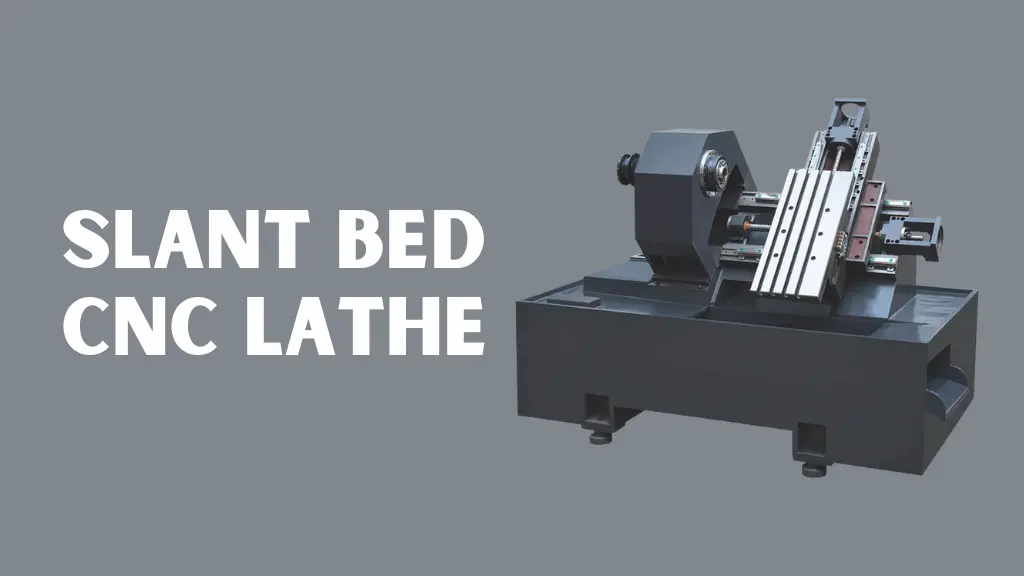A slant bed CNC lathe is a key investment for any modern machining facility. Its angled bed provides superior structural rigidity, improved chip evacuation, and enhanced operator ergonomics compared to traditional flat-bed machines. These advantages make it ideal for high-precision industries such as aerospace, automotive, energy, and medical manufacturing. Manufacturers gain consistent accuracy, higher efficiency, and reduced downtime.
This guide explains what makes this type of lathe unique, how it compares to conventional flat-bed machines, and which specifications matter most for production needs. You will also find expert insights, maintenance recommendations, and a practical checklist to help evaluate and select the right model. Following these guidelines ensures optimal performance and long-term reliability.
What is a Slant Bed CNC Lathe?
A slant bed CNC lathe is a turning center with its machine bed angled between 30 and 45 degrees. This design improves stiffness and stability, allowing the machine to maintain precision during heavy cutting operations. The angled layout enhances chip evacuation, keeping the work area cleaner and protecting critical components. It also allows better access for tool changes and part setups, reducing setup time.
Thanks to these structural advantages, the machine can perform high-speed finishing and multitasking operations with consistent accuracy. Its design supports demanding production runs while maintaining reliability. Operators benefit from improved ergonomics, while manufacturers achieve higher efficiency and output. Overall, this lathe combines precision, productivity, and durability in one machine.
Why Choose a Slant Bed Lathe?
The slant bed CNC lathe design is not just an aesthetic choice, but a result of precise engineering aimed at maximizing performance and reliability. Its angled bed provides exceptional structural rigidity, creating a stronger foundation that minimizes vibrations and enhances accuracy in both roughing and finishing operations.
The slanted geometry also improves chip evacuation, allowing gravity to guide chips away from the cutting area, which protects guideways and enhances surface finish. Operator ergonomics benefit as well, with easier access to parts and the turret, reducing setup times and improving workplace safety. Additionally, extended X-axis travel allows longer machining distances without increasing machine size, improving efficiency when handling larger components and complex parts.
Key Components to Evaluate
When choosing a CNC slant bed lathe, it is essential to carefully evaluate key components and available options. Guideways can be linear for high speed and precision or box ways for heavy-duty cutting tasks. The spindle should be assessed for bore size, horsepower, torque, and maximum RPM. A high-torque spindle is ideal for machining tougher alloys efficiently.
The turret, particularly one equipped with live tooling, allows milling and drilling in a single setup. This reduces the need for multiple operations and improves overall workflow. Tailstocks or sub-spindles are critical for long or complex parts that require complete machining in one pass. Considering these components ensures the machine can meet diverse production requirements.
CNC control systems like FANUC and Siemens offer advanced programming features and strong regional support. Their capabilities enhance machine flexibility, operator efficiency, and production reliability. Evaluating all these factors together guarantees optimal performance, higher productivity, and long-term dependability of the lathe.
Typical Specifications and Their Importance
Every manufacturer provides specifications, but not all buyers understand how to interpret them for optimal performance. The swing over bed and carriage defines the largest part diameter the machine can handle. Maximum turning length indicates the part size capacity. Spindle bore determines the maximum bar size suitable for automated feeding systems.
Spindle power and torque directly impact roughing efficiency and overall cycle times. Turret stations and live tooling options affect how many tools can be mounted and the scope of multitasking operations. Travel ranges and rapid traverse speeds dictate machining flexibility and production throughput. Understanding these factors ensures the angled CNC lathe meets both precision and productivity requirements.
Applications Across Industries
The slant bed Lathe is widely used across multiple industries due to its precision and versatility. In the automotive sector, it machines shafts, gear blanks, hubs, and transmission components efficiently. Aerospace applications include precision-critical rotating parts that demand strict tolerances. In the oil and gas industry, it handles long shafts, couplings, and heavy-duty fittings with reliability.
Medical manufacturing benefits from its ability to produce surgical implants and dental tools with high accuracy. General manufacturing leverages the angled CNC lathe for versatile, high-volume production of various components. Its adaptability and consistent performance make it a preferred choice for industries requiring both precision and efficiency.
How to Choose the Right CNC Slant Bed Lathe
Define your part mix by identifying the largest and smallest components you plan to machine. Match the spindle bore and swing capacity to your production requirements for optimal performance. Select appropriate tooling options, such as live tooling and Y-axis capabilities, to save setup time and increase versatility. Evaluate control systems carefully, considering operator familiarity and availability of regional support.
Consider automation solutions like bar feeders, robotic loaders, and chip conveyors to enable lights-out production. Check the service network to ensure parts availability and timely local support, reducing potential downtime. Review cycle-time benchmarks by testing the angled CNC lathe with actual parts before committing to full production. Following these steps ensures efficiency, reliability, and long-term productivity.
Installation and Setup Best Practices
Ensure a solid foundation and precise leveling to maintain machining accuracy. Proper alignment reduces vibrations and improves part quality during operation. Align chip conveyors and coolant systems with the bed angle for efficient chip removal. Correct setup minimizes production delays and protects critical machine components.
Use tool presetters and probes to reduce setup times and improve repeatability. Run acceptance tests to verify accuracy, surface finish, and overall machine performance before production. These steps ensure the slanted turning center operates reliably. Proper preparation supports consistent, high-quality machining results.
Provide operator training focused on control systems, tooling, and chip management. Well-trained staff enhances efficiency, reduces errors, and promotes safety. Following these best practices ensures optimal machine performance and higher productivity. This approach guarantees long-term reliability and reduced downtime.
Slant Bed CNC vs Flatbed CNC Lathe
A slant bed CNC lathe offers an angled bed that improves rigidity, chip evacuation, and operator ergonomics. In contrast, flatbed CNC lathes have a horizontal bed, which can limit chip flow and reduce accessibility. While flatbeds may be simpler and more affordable, they often lack the precision and productivity needed for complex, high-volume production.
The slanted layout provides better access to the turret and workpiece, reducing setup times and improving safety. Flatbeds may require more frequent interventions during long runs and can struggle with larger or longer parts. For facilities seeking higher throughput, multitasking, and superior part quality, the slant bed lathe is the preferred investment. Production needs, part complexity, and budget should guide the final choice.
Maintenance Tips
Perform daily checks of coolant levels, wipers, and hydraulic pressure to ensure the machine operates reliably. Regular inspections help prevent unexpected breakdowns and maintain consistent performance. Protecting guideways and ball screws with proper covers reduces wear and extends the life of critical components. Proper maintenance safeguards accuracy and prevents costly repairs over time.
Utilize thermal compensation features to minimize dimensional drift during long production runs. Predictive maintenance techniques, such as vibration analysis and spindle monitoring, can identify issues before they escalate. These proactive measures help maintain precision and uptime. Implementing a structured maintenance routine ensures the slant bed lathe delivers optimal efficiency and reliability.
Real-World Example
A medium-size manufacturer in the automotive sector replaced its old flat-bed lathes with a modern CNC slant bed lathe. By integrating live tooling and a bar feeder, the company reduced cycle times by nearly 30 percent. Overall machine uptime improved significantly, boosting production efficiency. The upgrade also enhanced operator workflow and reduced setup challenges.
The slanted design minimized chip-related stoppages, leading to smoother production. Part quality improved, meeting stricter tolerance requirements. This case illustrates the value of investing in advanced machining technology. Businesses adopting such solutions can achieve measurable gains in both efficiency and reliability.
Slant Bed Lathe in the Market
Global brands such as Mazak, DMG MORI, Doosan, Okuma, and KNUTH continue to expand their CNC slant bed lathe product lines. These machines are designed with modern features, including advanced controls and automation options, which allow manufacturers to handle both small-batch precision work and high-volume production efficiently.
Many of these lathes offer capabilities such as live tooling, sub-spindles, and integrated chip management systems, improving productivity and reducing setup times. For a broader overview of machine tool technology and industry trends, reputable industry references and technical guides can provide valuable insights.
Conclusion
A slant bed CNC lathe is widely recognized for its ability to combine precision, durability, and efficiency in modern manufacturing. Its angled design improves machine rigidity, enhances chip evacuation, and increases operator comfort, making it a reliable choice for industries that demand consistent high-quality output. By integrating this technology, businesses can achieve greater accuracy and reduce production delays, ensuring long-term competitiveness.
When selecting the right machine, decision makers should rely on expert advice, proven performance data, and real-world part testing. This ensures the chosen equipment aligns with production goals and budget considerations. With proper evaluation and guidance, this type of lathe becomes more than just a purchase. It is a strategic investment that delivers measurable improvements in efficiency, profitability, and manufacturing reliability.
FAQs
What industries use slant bed lathes the most?
Automotive, aerospace, energy, medical, and high-precision manufacturing benefit the most due to their demand for accuracy and efficient chip removal.
Is a CNC slant bed lathe always better than a flat bed?
Not always. For large workpieces or low-cost requirements, a flat bed can be more practical. For precision, productivity, and automation, slant beds are generally superior.
What spindle bore size should I consider?
Choose a bore slightly larger than your maximum bar size to ensure proper feeding and clamping.
Can slant bed be automated?
Yes. With bar feeders, part catchers, robotic loaders, and chip conveyors, they are well suited for lights-out manufacturing.
Which CNC control system is better?
FANUC is widely used for turning centers, while Siemens is preferred in some regions for multitasking. The choice depends on operator skill and local support.




